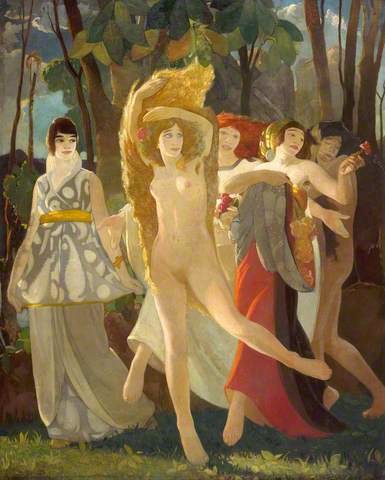Found - this article Unisex, 1910-Style in a forgotten antiques bulletin The Four in Hand Letter from May 1970. It billed itself as The Fortnightly Guide to Collecting for Profit (Art Antiques Junk Valuables). Very much for the intelligent dealer and stall holder of the time with its eye on prices and trends. It tips the fringe PRB painter Simeon Solomon as an artist to watch, a painting of his recently made a 6 figure sum but he could then be bought for less than a £1000 for an oil. The artists mentioned here are still quite obscure with no art books or Catalogues Raisonnées available ...[in 2 parts with the first mostly on Eric Robertson and the second on Nicholas Kalmakoff]
Unisex, 1910-Style
 |
| Eric Harald Macbeth Robertson (1887-1941) |
It's only recently that the weird and wonderful artists working at the beginning of this century have been given a name -- the Symbolists. Strangely enough, it's also only during the last few years that many of them have been discovered, which perhaps is the reason why the craze for Symbolist paintings is beginning to crackle.
Before the Symbolists it was the Pre-Raphaelites, that group of fervent mediaevalists such as Rossetti, Holman, Hunt, Millais, Arthur Hughes and several others who were chiefly working during the 1840s to 1860s.
Gradually the pure grace and beauty of the Pre-Raphaelite paintings begang to pall and a few artists, influenced by Beardsley, started to produce paintings that, although equal to the previous style in quality and draughtsmanship, often had a rather perverted and macabre feeling about them. Artists were beginning to question the meaning of life and death, and to become obsessed with the idea of evil and degradation in beauty. The result was a number of paintings, full of strange eroticism, in which men and women with beautiful bored faces are given curiously asexual bodies (in fact, in some cases, it's difficult to tell which is which).
An artist whose work has this look of frozen sensuality about it is Eric Robertson, who until the beginning of this year was virtually unheard of.
Robertson was born in Dumfries in 1887. He studied at the Royal Institute, Edinburgh and then attended the 1908-9 session at the Edinburgh College of Art. In 1912 the Edinburgh group held its first exhibition and soon achieved a certain amount of fame -- Frederick Quinton mentioned in The National Outlook, November, 1920, that 'usually people look to the Edinburgh Group, as we know them, for something unique rather than universal; for something of pagan brazenness rather than parlour propriety'.

The other members of the group included A. R. Sturrock, J. R. Barclay, W. O. Hutchinson, J. G. Spence Smith, Dorothy Johnstone, D. M. Sutherland, Mary Newbery, and Cecile Walton, whom Eric Robertson married in 1914. It was during this marriage that Robertson's best works were created -- they are free from the contemporary inhibitions and extraordinarily well-drawn and painted.
Towards the end of the 1923 his marriage to Cecile Walton was starting to break up and his work gradually declined. In 1924 he moved to Liverpool and got married again and although he produced a few things of interest his artistic career was virtually at an end.
In March this year a very successful exhibition of his work was held -- the first since the Edinburgh days. The painting and drawings had been in the possession of some relations of his second wife and they had suddenly decided to get rid of them. Prices for the painting and drawings were very low but already they are rising rapidly.
(Incidentally, there has also been a sudden price rise over the last months for the work of SIMEON SOLOMON, A LATER FOLLOWER OF THE PRE-RAPHAELITE MOVEMENT).

